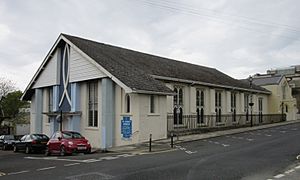St James' Church, Ryde facts for kids
Quick facts for kids St. James's Church, Ryde |
|
|---|---|
 |
|
| Denomination | Anglican Mission in England |
| Churchmanship | Conservative Evangelical |
| History | |
| Dedication | St. James |
St. James's Church, Ryde is a special kind of church building in Ryde, a town on the Isle of Wight. It's called a "proprietary chapel" because it's owned by a group of people, not directly by the main church organization. Until 2020, it was part of the Church of England. Then, it decided to join a different group called the Anglican Mission in England.
Contents
The Story of St. James's Church
This church was built in 1827 on Lind Street. It was only the second Church of England building in Ryde at that time. A person named W. Hughes asked for it to be built. His brother, Revd. Augustus Hewitt, was the very first minister.
Early Owners and Leaders
Both brothers left the church in 1830. W. Hughes became a Member of Parliament (M.P.) for Oxford. After they left, Revd. Richard Waldo Sibthorp bought the church. He was a Fellow at Magdalen College, Oxford. He led the church's services until 1841.
Over the years, the church was owned by different people. Then, in 1903, it was given to a group of five trustees. These trustees still look after the church today. Since 1904, St. James's Church has been part of the Church Society group of churches.
The Church Organ
The church's first organ was built in 1911 by James Ivemey from Southampton. Later, this organ was replaced. The new organ came from a Methodist church on St. Peter's Street in Winchester. We know that a person called 'Miss Watts' was one of the organists around 1921. You can find details about the organ on the National Pipe Organ Register website.
St. James's Church Today
St. James's Church is still very active. They have church services every Sunday at 10:30 AM and 6:30 PM. The church also has many groups for young people and other groups that meet during the week.
The church follows a Conservative Evangelical tradition. This means they have certain beliefs about how the church should be run. Before leaving the Church of England, they held beliefs that did not support women becoming priests.

